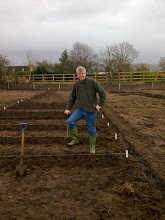Picking up where I left off yesterday, the next crop for the annual appraisal treatment is the strawberries-
Strawberries: 9 out of 10.
I had a lovely harvest of fat, sweet, delicious strawberries last Summer. They went down very well at home and also with a pedestrian blackbird which is often seen walking around the allotment site. Presumably it is too full of allotment produce to take off or perhaps it has a strawberry tucked under each wing. The strawberries also surprised me with a small late crop in the Autumn long after I thought they had finished for the year. I hope that the Autumn crop hasn't upset their biological clocks for production this year. The Strawberry plants have sent out a few off-shoots which have grown in my pathways. I will dig these up and re-plant them when I get round to the long overdue job of weeding the strawberry bed.
Rhubarb: 7 out of 10
The rhubarb bed, like the asparagus bed, is still in the early years of a long term project and so last year I took care to harvest conservatively so as to give the plants the best chance to get themselves well established ready to produce masses of crumble fodder for years to come.
My main criticism of the rhubarb last year was that some of the stalks were a little on the thin side. I put this down to a failure on my part to adequately feed the soil. I have sought to remedy this over the Winter by spreading a layer of compost over them along with a good barrow load and a half of manure. I feared the worst at the end of March. Where other plot-holders had good early growth of thick red stems and luscious green leaves I had nothing more than a pile of dung and a huge thistle.
My neighbour Rick took pity on me. His rampant rhubarb was on the march and was threatening to occupy a vast area of his plot. He fought it back with the flashing blade of his spade and presented me with a huge chunk of root which was sprouting some healthy looking stalks. Within a week of planting Rick's rhubarb, in a spot next to the greenhouse, my own rhubarb bed dragged itself out of hibernation and it is now shooting proudly and relentlessly skywards as if to mock me for ever doubting it.
Carrots: 6 out of 10
I had mixed results with carrots last year. I found that the above ground appearance of the carrot gives no reliable indication as to what you can expect to find growing underground. It was often the case that I would take a firm hold of a large bushy green carrot top expecting to tug and tease a long length of orange root out of the ground only to find that the masses of verdant bush were attached to nothing more than a two inch tiddler which resembled a well worn Ikea pencil. On other occasions I would take hold of a weak looking carrot top with the intention of thinning it out from the row only to find a fully grown, perfectly shaped carrot attached.
Late on in the season some of the carrots were attacked by carrot fly grubs but the carrots had grown so large as to still leave a decent edible portion for me even after the blackened carrot fly tainted area had been excised.
I will persevere with carrots this year, not least because they are a vital ingredient in my beetroot chutney. I have already sown three rows of carrots in a manure free raised bed and I will sow more over the coming weeks. At the moment the carrot-fly protection consists of a fleece tunnel over the carrots and a row of onions surrounding the bed but when I get some time I intend to construct a raised screen to protect the bed from carrot-fly attack.
Onions: 8 out of 10
Red onions and yellow onions grown from sets did reasonably well last year. This year I have already planted a couple of hundred sets in one of the raised beds. This is in addition to those which I have planted in the carrot bed. I still have some others to squeeze in somewhere. Learning from mistakes made in previous years I have planted the rows of onions a little further apart than is suggested on the packet. By doing this I will, hopefully, have left enough room between the rows to allow me to reach weeds with my narrow headed hoe without disturbing the onions, even when the onions have grown nice and fat.
To be continued...
Tuesday, 10 April 2012
Subscribe to:
Post Comments (Atom)











No comments:
Post a Comment